Radxa Rock is an Android & Linux development board based on Rockchip RK3188 with 2GB RAM, 8GB NAND Flash, several I/Os that’s been available in beta version to a small number of developers in September 2013, with general availability starting at the very end of December 2013. Radxa team has sent me a board for me to try out. I’ll start with some unboxing pictures, write a Quick Start Guide for the first boot with Android 4.2.2, and run some benchmarks on the board. In another post, I’ll try some of the instructions to build Android and Ubuntu for the platform.
Radxa Rock Unboxing Pictures & Video
I’ve received the board in the following package via Fedex.
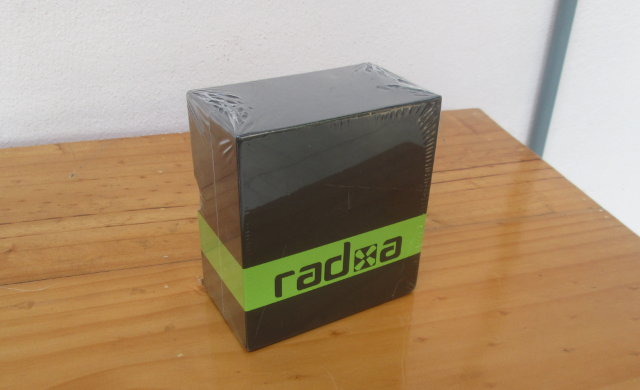 Beside the board, we’ve got a Wi-Fi antenna, a USB power cable, and a plastic casing.
Beside the board, we’ve got a Wi-Fi antenna, a USB power cable, and a plastic casing.
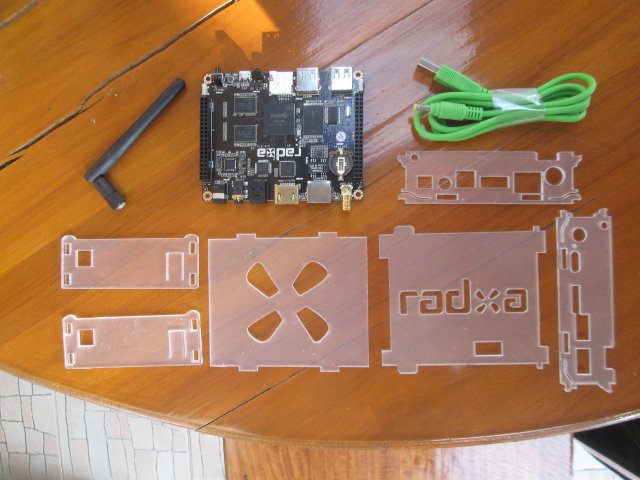
Checkout Radxa Rock unboxing video below, if you want to find out exactly what’s you get when you receive the board.
Let’s have a closer look at the board.
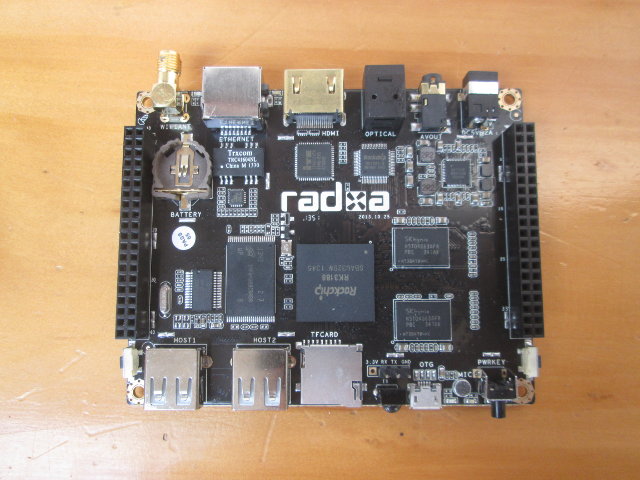
The top of the board gets most of the interesting bits. From the bottom right, clockwise: power button, microphone, micro USB OTG port, IR receiver, UART header for serial console, micro SD card, 2x USB 2.0 ports, recovery button, 40 pin “GPIO” header, battery slot, Wi-Fi antenna connector, 10/100M Ethernet port, HDMI output, S/PDIF optical output, AV out, power jack, another 40-pin header, and the reset switch.
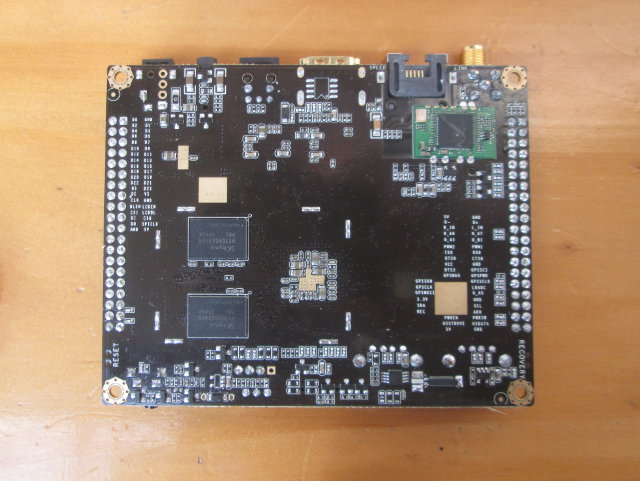
On the back of the board, we’ve got the Wi-Fi/Bluetooth module (Realtek RTL8723AS), two more RAM chips, as well as the name of all 80 header pins on the silkscreen of the board, which can be convenient.
Radxa Rock Case Assembly
Radxa Rock comes with a plastic case that you have to assemble. It does not look the best, but it’s functional, and both easy to assemble and disassemble. Start by inserting two sides (length) into the base, place the board in the case, add the cover, and finish the assembly by adding the two other sides (width). You’ll also want to add the Wi-Fi antenna, if you plan to use Wi-Fi. At no point you need to force during assembly or disassembly, so it’s unlikely you’ll break the enclosure.
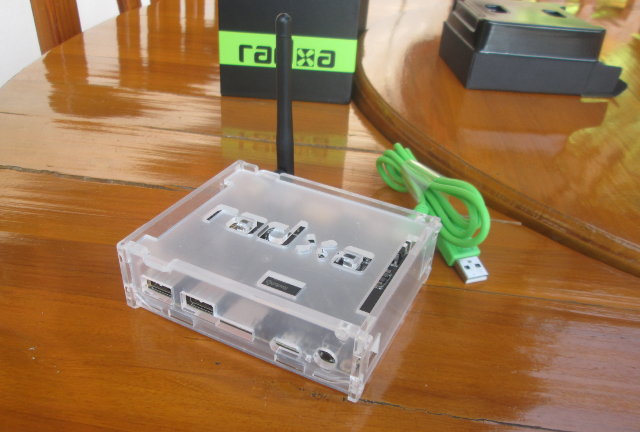
The box has been designed so that you can access all ports, including the two 40-pin expansion headers, and the UART header. The two USB ports are a little deep inside though, so I’m not sure if it will work with all USB peripherals, and you’ll have to insert the microSD card before assembly, or using a small tool, e.g. toothpick, to push the card.
[Update: To see how the casing is assembled as well unboxing and first boot, you can also watch that video]
Quick Start Guide for Radxa Rock
I’ve connected an HDMI cable to a TV, an Ethernet cable to a hub, a serial debug board for console access, a USB RF dongle for Mele F10 air mouse, and I used Tronsmart T428 (5V/2A) power adapter for power.
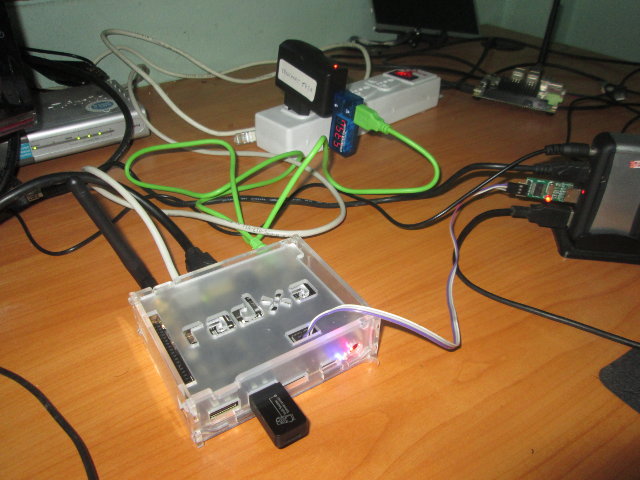 The power starts immediately, i.e. there’s no need to press the power button, which is only used to turn off the board, and during boot you’ll see 4 Linux penguins (Tux), an animated “radxa” logo, and after just over 30 seconds you’ll get to the Android Home screen. I’ve tried to take a few screenshots by installing trial versions of apps such as Screenshot IT and Screenshot UX, but the board would just lose display output while taking screenshots, and I’d just see “No signal” message from my TV, requiring a press of the reset button.
The power starts immediately, i.e. there’s no need to press the power button, which is only used to turn off the board, and during boot you’ll see 4 Linux penguins (Tux), an animated “radxa” logo, and after just over 30 seconds you’ll get to the Android Home screen. I’ve tried to take a few screenshots by installing trial versions of apps such as Screenshot IT and Screenshot UX, but the board would just lose display output while taking screenshots, and I’d just see “No signal” message from my TV, requiring a press of the reset button.
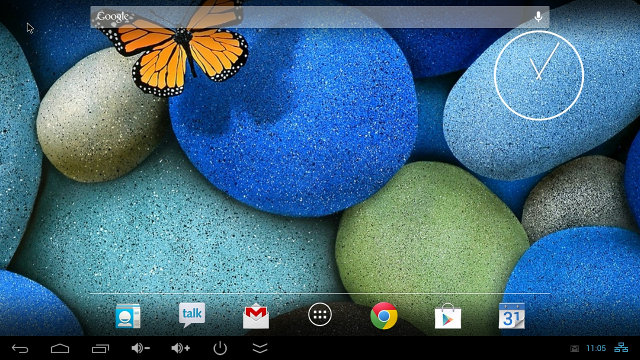
I could see the kernel messages from the serial console, but for some reasons I was not able to input anything in minicom. This is probably not an issue with Radxa board, as I’ve add this issue randomly with other devices too.
Here’s the boot log for reference:
In
DDR3
300MHz
Bus Width=32 Col=10 Bank=8 Row=15 CS=2 Die Bus-Width=16 Size=2048MB
Memory OK
OUT
BUILD=====5
F:32 1061 2 0 40
GetRemapTbl flag = 0
OK! 51786
unsigned!
SecureBootEn = 0 0
Boot ver: 2013-06-20#1.24
start_linux=====63508
2292032 Starting kernel…@0x60408000[ 0.000000] Initializing cgroup subsys cpu
[ 0.000000] Linux version 3.0.36+ (ty@fae) (gcc version 4.6.x-google 20120103
[ 0.000000] CPU: ARMv7 Processor [413fc090] revision 0 (ARMv7), cr=10c5387d
[ 0.000000] CPU: VIPT nonaliasing data cache, VIPT aliasing instruction cache
[ 0.000000] Machine: RK30board
[ 0.000000] memory reserve: Memory(base:0x8f000000 size:120M) reserved for <>
[ 0.000000] memory reserve: Memory(base:0x8e500000 size:11M) reserved for <f>
[ 0.000000] memory reserve: Memory(base:0x8dd00000 size:8M) reserved for <ca>
[ 0.000000] memory reserve: Total reserved 139M
[ 0.000000] Memory policy: ECC disabled, Data cache writeback
[ 0.000000] bootconsole [earlycon0] enabled
[ 0.000000] CPU SRAM: copied sram code from c0b55000 to fef00100 – fef02198
[ 0.000000] CPU SRAM: copied sram data from c0b57098 to fef02198 – fef0291c
[ 0.000000] sram_log: 4q ?& : 4q ?) !?, # 0q *! ! 3q
[ 0.000000] CLKDATA_MSG: pll_flag = 0x00
[ 0.000000] CLKDATA_ERR: can’t get a available nume and deno
[ 0.000000] CLKDATA_ERR: clk_frac_div can’t get rate=48000000,uart0_fracv
[ 0.000000] L310 cache controller enabled
[ 0.000000] l2x0: 16 ways, CACHE_ID 0x4100c0c8, AUX_CTRL 0x76050001, Cache sB
[ 0.000000] DDR DEBUG: version 1.00 20130712
[ 0.000000] DDR DEBUG: DDR3 Device
[ 0.000000] DDR DEBUG: Bus Width=32 Col=10 Bank=8 Row=15 CS=2 Total CapabiliB
[ 0.000000] DDR DEBUG: init success!!! freq=300MHz
[ 0.000000] DDR DEBUG: DTONE=0x3, DTERR=0x0, DTIERR=0x0, DTPASS=0x23, DGSL=10
[ 0.000000] DDR DEBUG: DTONE=0x3, DTERR=0x0, DTIERR=0x0, DTPASS=0x24, DGSL=10
[ 0.000000] DDR DEBUG: DTONE=0x3, DTERR=0x0, DTIERR=0x0, DTPASS=0x24, DGSL=10
[ 0.000000] DDR DEBUG: DTONE=0x3, DTERR=0x0, DTIERR=0x0, DTPASS=0x24, DGSL=00
[ 0.000000] DDR DEBUG: ZERR=0, ZDONE=0, ZPD=0x0, ZPU=0x0, OPD=0x0, OPU=0x0
[ 0.000000] DDR DEBUG: DRV Pull-Up=0xb, DRV Pull-Dwn=0xb
[ 0.000000] DDR DEBUG: ODT Pull-Up=0x2, ODT Pull-Dwn=0x2
[ 0.000000] PERCPU: Embedded 7 pages/cpu @c313f000 s6976 r8192 d13504 u32768
[ 0.000000] Built 1 zonelists in Zone order, mobility grouping on. Total pa8
[ 0.000000] Kernel command line: console=ttyFIQ0 console=tty0 androidboot.co2
[ 0.000000] PID hash table entries: 4096 (order: 2, 16384 bytes)
[ 0.000000] Dentry cache hash table entries: 131072 (order: 7, 524288 bytes)
[ 0.000000] Inode-cache hash table entries: 65536 (order: 6, 262144 bytes)
[ 0.000000] Memory: 733MB 1176MB = 1909MB total
[ 0.000000] Memory: 1917812k/1917812k available, 179340k reserved, 1204224K m
[ 0.000000] Virtual kernel memory layout:
[ 0.000000] vector : 0xffff0000 – 0xffff1000 ( 4 kB)
[ 0.000000] fixmap : 0xfff00000 – 0xfffe0000 ( 896 kB)
[ 0.000000] DMA : 0xff600000 – 0xffe00000 ( 8 MB)
[ 0.000000] vmalloc : 0xf7000000 – 0xfe800000 ( 120 MB)
[ 0.000000] lowmem : 0xc0000000 – 0xf6800000 ( 872 MB)
[ 0.000000] pkmap : 0xbfe00000 – 0xc0000000 ( 2 MB)
[ 0.000000] modules : 0xbf000000 – 0xbfe00000 ( 14 MB)
[ 0.000000] .init : 0xc0408000 – 0xc0434000 ( 176 kB)
[ 0.000000] .text : 0xc0434000 – 0xc0ae17f4 (6838 kB)
[ 0.000000] .data : 0xc0ae2000 – 0xc0b546a8 ( 458 kB)
[ 0.000000] .bss : 0xc0b58024 – 0xc15fdc58 (10904 kB)
[ 0.000000] SLUB: Genslabs=13, HWalign=32, Order=0-3, MinObjects=0, CPUs=4, 1
[ 0.000000] Preemptible hierarchical RCU implementation.
[ 0.000000] NR_IRQS:352
[ 0.000000] rk30_gpio_init: 128 gpio irqs in 4 banks
[ 0.000000] sched_clock: 32 bits at 24MHz, resolution 41ns, wraps every 1789s
[ 0.000000] rk_timer: version 1.2
[ 0.000000] Console: colour dummy device 80×30
[ 0.000000] console [tty0] enabled, bootconsole disabled
<hit enter to activate fiq debugger>
[ 0.000000] Initializing cgroup subsys cpu
[ 0.000000] Linux version 3.0.36+ (ty@fae) (gcc version 4.6.x-google 20120103
[ 0.000000] CPU: ARMv7 Processor [413fc090] revision 0 (ARMv7), cr=10c5387d
[ 0.000000] CPU: VIPT nonaliasing data cache, VIPT aliasing instruction cache
[ 0.000000] Machine: RK30board
[ 0.000000] memory reserve: Memory(base:0x8f000000 size:120M) reserved for <>
[ 0.000000] memory reserve: Memory(base:0x8e500000 size:11M) reserved for <f>
[ 0.000000] memory reserve: Memory(base:0x8dd00000 size:8M) reserved for <ca>
[ 0.000000] memory reserve: Total reserved 139M
[ 0.000000] Memory policy: ECC disabled, Data cache writeback
[ 0.000000] bootconsole [earlycon0] enabled
[ 0.000000] CPU SRAM: copied sram code from c0b55000 to fef00100 – fef02198
[ 0.000000] CPU SRAM: copied sram data from c0b57098 to fef02198 – fef0291c
[ 0.000000] sram_log: 4q ?& : 4q ?) !?, # 0q *! ! 3q
[ 0.000000] CLKDATA_MSG: pll_flag = 0x00
[ 0.000000] CLKDATA_ERR: can’t get a available nume and deno
[ 0.000000] CLKDATA_ERR: clk_frac_div can’t get rate=48000000,uart0_fracv
[ 0.000000] L310 cache controller enabled
[ 0.000000] l2x0: 16 ways, CACHE_ID 0x4100c0c8, AUX_CTRL 0x76050001, Cache sB
[ 0.000000] DDR DEBUG: version 1.00 20130712
[ 0.000000] DDR DEBUG: DDR3 Device
[ 0.000000] DDR DEBUG: Bus Width=32 Col=10 Bank=8 Row=15 CS=2 Total CapabiliB
[ 0.000000] DDR DEBUG: init success!!! freq=300MHz
[ 0.000000] DDR DEBUG: DTONE=0x3, DTERR=0x0, DTIERR=0x0, DTPASS=0x23, DGSL=10
[ 0.000000] DDR DEBUG: DTONE=0x3, DTERR=0x0, DTIERR=0x0, DTPASS=0x24, DGSL=10
[ 0.000000] DDR DEBUG: DTONE=0x3, DTERR=0x0, DTIERR=0x0, DTPASS=0x24, DGSL=10
[ 0.000000] DDR DEBUG: DTONE=0x3, DTERR=0x0, DTIERR=0x0, DTPASS=0x24, DGSL=00
[ 0.000000] DDR DEBUG: ZERR=0, ZDONE=0, ZPD=0x0, ZPU=0x0, OPD=0x0, OPU=0x0
[ 0.000000] DDR DEBUG: DRV Pull-Up=0xb, DRV Pull-Dwn=0xb
[ 0.000000] DDR DEBUG: ODT Pull-Up=0x2, ODT Pull-Dwn=0x2
[ 0.000000] PERCPU: Embedded 7 pages/cpu @c313f000 s6976 r8192 d13504 u32768
[ 0.000000] Built 1 zonelists in Zone order, mobility grouping on. Total pa8
[ 0.000000] Kernel command line: console=ttyFIQ0 console=tty0 androidboot.co2
[ 0.000000] PID hash table entries: 4096 (order: 2, 16384 bytes)
[ 0.000000] Dentry cache hash table entries: 131072 (order: 7, 524288 bytes)
[ 0.000000] Inode-cache hash table entries: 65536 (order: 6, 262144 bytes)
[ 0.000000] Memory: 733MB 1176MB = 1909MB total
[ 0.000000] Memory: 1917812k/1917812k available, 179340k reserved, 1204224K m
[ 0.000000] Virtual kernel memory layout:
[ 0.000000] vector : 0xffff0000 – 0xffff1000 ( 4 kB)
[ 0.000000] fixmap : 0xfff00000 – 0xfffe0000 ( 896 kB)
[ 0.000000] DMA : 0xff600000 – 0xffe00000 ( 8 MB)
[ 0.000000] vmalloc : 0xf7000000 – 0xfe800000 ( 120 MB)
[ 0.000000] lowmem : 0xc0000000 – 0xf6800000 ( 872 MB)
[ 0.000000] pkmap : 0xbfe00000 – 0xc0000000 ( 2 MB)
[ 0.000000] modules : 0xbf000000 – 0xbfe00000 ( 14 MB)
[ 0.000000] .init : 0xc0408000 – 0xc0434000 ( 176 kB)
[ 0.000000] .text : 0xc0434000 – 0xc0ae17f4 (6838 kB)
[ 0.000000] .data : 0xc0ae2000 – 0xc0b546a8 ( 458 kB)
[ 0.000000] .bss : 0xc0b58024 – 0xc15fdc58 (10904 kB)
[ 0.000000] SLUB: Genslabs=13, HWalign=32, Order=0-3, MinObjects=0, CPUs=4, 1
[ 0.000000] Preemptible hierarchical RCU implementation.
[ 0.000000] NR_IRQS:352
[ 0.000000] rk30_gpio_init: 128 gpio irqs in 4 banks
[ 0.000000] sched_clock: 32 bits at 24MHz, resolution 41ns, wraps every 1789s
[ 0.000000] rk_timer: version 1.2
[ 0.000000] Console: colour dummy device 80×30
[ 0.000000] console [tty0] enabled, bootconsole disabled
[ 0.014180] Calibrating delay loop (skipped) preset value.. 1631.46 BogoMIPS)
[ 0.014209] pid_max: default: 32768 minimum: 301
[ 0.014399] Mount-cache hash table entries: 512
[ 0.014909] Initializing cgroup subsys debug
[ 0.014931] Initializing cgroup subsys cpuacct
[ 0.014970] Initializing cgroup subsys freezer
[ 0.015003] CPU: Testing write buffer coherency: ok
[ 0.095826] CPU1: Booted secondary processor
[ 0.135818] CPU2: Booted secondary processor
[ 0.175818] CPU3: Booted secondary processor
[ 0.175847] Brought up 4 CPUs
[ 0.175884] SMP: Total of 4 processors activated (6525.87 BogoMIPS).
[ 0.176217] devtmpfs: initialized
[ 0.182178] NET: Registered protocol family 16
[ 0.182279] last_log: 0xed900000 map to 0xf7004000 and copy to 0xc0b5c1a0 (v)
[ 0.196766] DVFS MSG: AVS Value(index=0): 114 114 114 114 114 114 114
[ 0.315475] lcdc0 is used as external display device contoller!
[ 0.315518] lcdc1 is used as primary display device controller!
[ 0.415786] rk29sdk_wifi_bt_gpio_control_init: init finished
[ 0.419594] console [ttyFIQ0] enabled
[ 0.419741] Registered FIQ tty driver ed83dcc0
[ 0.926124] bio: create slab <bio-0> at 0
[ 0.930527] SCSI subsystem initialized
[ 0.930738] usbcore: registered new interface driver usbfs
[ 0.930864] usbcore: registered new interface driver hub
[ 0.945115] usbcore: registered new device driver usb
[ 0.945385] rk30_i2c rk30_i2c.0: i2c-0: RK30 I2C adapter
[ 0.945651] rk30_i2c rk30_i2c.1: i2c-1: RK30 I2C adapter
[ 0.945846] rk30_i2c rk30_i2c.2: i2c-2: RK30 I2C adapter
[ 0.946007] rk30_i2c rk30_i2c.3: i2c-3: RK30 I2C adapter
[ 0.946309] rk30_i2c rk30_i2c.4: i2c-4: RK30 I2C adapter
[ 0.976723] rk30-adc rk30-adc: rk30 adc: driver initialized
[ 0.977019] Advanced Linux Sound Architecture Driver Version 1.0.24.
[ 0.977470] Bluetooth: Core ver 2.16
[ 0.977551] NET: Registered protocol family 31
[ 0.977603] Bluetooth: HCI device and connection manager initialized
[ 0.977672] Bluetooth: HCI socket layer initialized
[ 0.977724] Bluetooth: L2CAP socket layer initialized
[ 0.977790] Bluetooth: SCO socket layer initialized
[ 0.978862] rk fb probe ok!
[ 0.983665] act8846_set_init,line=17
[ 0.983713] act8846_set_init:g_pmic_type=3
[ 0.985507] act8846_set_init act_dcdc1 =1200000mV end
[ 0.987393] act8846_set_init vdd_core =1000000mV end
[ 0.989276] act8846_set_init vdd_cpu =1000000mV end
[ 0.991157] act8846_set_init act_dcdc4 =3300000mV end
[ 0.992410] act8846_set_init act_ldo1 =1000000mV end
[ 0.994191] act8846_set_init act_ldo2 =1200000mV end
[ 0.995973] act8846_set_init act_ldo3 =1800000mV end
[ 0.997757] act8846_set_init act_ldo4 =3300000mV end
[ 0.999539] act8846_set_init act_ldo5 =3300000mV end
[ 1.001319] act8846_set_init act_ldo6 =1800000mV end
[ 1.002470] act8846_set_init act_ldo7 =1800000mV end
[ 1.004252] act8846_set_init act_ldo8 =2800000mV end
[ 1.004314] act8846_set_init,line=78 END
[ 1.004392] i2c-core: driver [act8846] using legacy suspend method
[ 1.004457] i2c-core: driver [act8846] using legacy resume method
[ 1.004555] rk1000_control_probe
[ 1.029546] rk1000_control_probe ok
[ 1.029641] Switching to clocksource rk_timer
[ 1.035218] Switched to NOHz mode on CPU #0
[ 1.035856] Switched to NOHz mode on CPU #2
[ 1.035870] Switched to NOHz mode on CPU #3
[ 1.035883] Switched to NOHz mode on CPU #1
[ 1.036495] lcdc1:reg_phy_base = 0x1010e000,reg_vir_base:0xf709c000
[ 1.036607] fb0:win0
[ 1.036612] fb1:win1
[ 1.036617] fb2:win2
[ 1.036733] rk3188 lcdc1 clk enable…
[ 1.036795] rk3188 lcdc1 clk disable…
[ 1.064043] fb0:phy:8e500000>>vir:f8000000>>len:0xb00000
[ 1.064314] rk_fb_register>>>>>fb0
[ 1.064640] rk_fb_register>>>>>fb1
[ 1.065084] rk3188 lcdc1 probe ok!
[ 1.065152] lcdc0:reg_phy_base = 0x1010c000,reg_vir_base:0xf70a8000
[ 1.065238] fb0:win0
[ 1.065243] fb1:win1
[ 1.065247] fb2:win2
[ 1.065360] rk3188 lcdc0 clk enable…
[ 1.065413] rk3188 lcdc0 clk disable…
[ 1.065460] fb2:phy:8e500000>>vir:f8000000>>len:0xb00000
[ 1.065681] rk_fb_register>>>>>fb2
[ 1.065954] rk_fb_register>>>>>fb3
[ 1.065999] rk3188 lcdc0 probe ok!
[ 1.127986] IT66121 probe success.
[ 1.137628] cfg80211: Calling CRDA to update world regulatory domain
[ 1.213553] NET: Registered protocol family 2
[ 1.213716] IP route cache hash table entries: 32768 (order: 5, 131072 bytes)
[ 1.214161] TCP established hash table entries: 131072 (order: 8, 1048576 by)
[ 1.216127] TCP bind hash table entries: 65536 (order: 7, 786432 bytes)
[ 1.217323] TCP: Hash tables configured (established 131072 bind 65536)
[ 1.217393] TCP reno registered
[ 1.217436] UDP hash table entries: 512 (order: 2, 16384 bytes)
[ 1.217523] UDP-Lite hash table entries: 512 (order: 2, 16384 bytes)
[ 1.217892] NET: Registered protocol family 1
[ 1.218165] RK29 Backlight Driver Initialized.
[ 1.218392] Unpacking initramfs…
[ 1.276438] [EDID] check header error
[ 1.276503] (NULL device *): [HDMI] parse edid base block error
[ 1.276585] (NULL device *): warning: EDID error, assume sink as HDMI !!!!
[ 1.276652] (NULL device *): warning: no CEA video mode parsed from EDID !!!*
[ 1.276765] Support video mode:
[ 1.276801] 1920x1080p@60Hz.
[ 1.276835] 1920x1080p@50Hz.
[ 1.276868] 1280x720p@60Hz.
[ 1.276900] 1280x720p@50Hz.
[ 1.276931] 720x576p@50Hz.
[ 1.276962] 720x480p@60Hz.
[ 1.276993] ******** Show Sink Info ********
[ 1.277061] rk3188 lcdc1 clk enable…
[ 1.277114] lcdc1: dclk:74250000>>fps:60
[ 1.277159] rk30-lcdc rk30-lcdc.1: rk3188_load_screen for lcdc1 ok!
[ 1.277231] lcdc1: dclk:74250000>>fps:60
[ 1.277273] rk30-lcdc rk30-lcdc.1: rk3188_load_screen for lcdc1 ok!
[ 1.277341] lcdc1 wakeup from standby!
[ 1.277383] lcdc1 win0 open,atv layer:1
[ 1.282616] Freeing initrd memory: 1216K
[ 1.282733] PMU: registered new PMU device of type 0
[ 1.282912] DVFS MSG: core: dvfs_adjust_table_lmtvolt get leakage_level = 3
[ 1.282989] DVFS MSG: aclk_gpu: dvfs_adjust_table_lmtvolt get leakage_level 3
[ 1.382349] rk3188 cpufreq version 2.1, suspend freq 816 MHz
[ 1.382969] Loaded driver for PL330 DMAC-1 rk29-pl330
[ 1.383031] DBUFF-32x8bytes Num_Chans-6 Num_Peri-12 Num_Events-12
[ 1.383252] Loaded driver for PL330 DMAC-2 rk29-pl330
[ 1.383315] DBUFF-64x8bytes Num_Chans-7 Num_Peri-20 Num_Events-14
[ 1.410619] highmem bounce pool size: 64 pages
[ 1.410832] ashmem: initialized
[ 1.420066] fuse init (API version 7.16)
[ 1.424803] Block layer SCSI generic (bsg) driver version 0.4 loaded (major )
[ 1.424886] io scheduler noop registered
[ 1.424933] io scheduler deadline registered
[ 1.425015] io scheduler cfq registered (default)
[ 1.445254] rga: Driver loaded succesfully
[ 1.445378] rk3188 lcdc0 clk enable…
[ 1.445428] lcdc0: dclk:74250000>>fps:60
[ 1.445469] rk30-lcdc rk30-lcdc.0: rk3188_load_screen for lcdc0 ok!
[ 1.445958] lcdc0: dclk:27000000>>fps:60
[ 1.448266] rk30-lcdc rk30-lcdc.0: rk3188_load_screen for lcdc0 ok!
[ 1.448333] lcdc0: dclk:27000000>>fps:60
[ 1.450644] rk30-lcdc rk30-lcdc.0: rk3188_load_screen for lcdc0 ok!
[ 1.450707] lcdc0 wakeup from standby!
[ 1.450746] lcdc0 win0 open,atv layer:1
[ 1.450794] rk1000_tv ver 2.0 probe ok
[ 1.451033] rk_serial.c v1.3 2012-12-14
[ 1.451316] rk_serial rk_serial.0: dma_rx_buffer 0xffdfc000
[ 1.451373] rk_serial rk_serial.0: dma_rx_phy 0x8c956000
[ 1.451431] rk_serial rk_serial.0: serial_rk_init_dma_rx sucess
[ 1.451491] rk_serial.0: ttyS0 at MMIO 0x10124000 (irq = 66) is a rk29_seria0
[ 1.629797] rk_serial rk_serial.0: membase 0xf70c0000
[ 1.630036] rk_serial.3: ttyS3 at MMIO 0x20068000 (irq = 69) is a rk29_seria3
[ 1.789791] rk_serial rk_serial.3: membase 0xf70c8000
[ 1.790825] Rockchip ion module(version: 1.0) is successfully loaded
[ 1.797301] loop: module loaded
[ 1.797447] Android kernel panic handler initialized (bind=kpanic)
[ 2.800542] rk29 vmac rk29 vmac.0: ARC VMAC at 0x10204000 irq 51 62:5f:65:2cd
[ 2.800639] PPP generic driver version 2.4.2
[ 2.800783] PPP Deflate Compression module registered
[ 2.800825] PPP BSD Compression module registered
[ 2.822530] PPP MPPE Compression module registered
[ 2.822581] NET: Registered protocol family 24
[ 2.822672] usbcore: registered new interface driver asix
[ 2.822744] usbcore: registered new interface driver cdc_ether
[ 2.822808] usbcore: registered new interface driver dm9620
[ 2.822870] usbcore: registered new interface driver SR9700_android
[ 2.822934] usbcore: registered new interface driver net1080
[ 2.822997] usbcore: registered new interface driver cdc_subset
[ 2.823060] usbcore: registered new interface driver zaurus
[ 2.823111] cdc_ncm: 04-Aug-2011
[ 2.823155] usbcore: registered new interface driver cdc_ncm
[ 2.823199] Rockchip WiFi SYS interface (V1.00) …
[ 2.823261] Initializing USB Mass Storage driver…
[ 2.823326] usbcore: registered new interface driver usb-storage
[ 2.823375] USB Mass Storage support registered.
[ 2.823475] usbcore: registered new interface driver usbserial
[ 2.823537] USB Serial support registered for generic
[ 2.823599] usbcore: registered new interface driver usbserial_generic
[ 2.823649] usbserial: USB Serial Driver core
[ 2.823698] USB Serial support registered for GSM modem (1-port)
[ 2.823769] usbcore: registered new interface driver option
[ 2.823812] option: v0.7.2:USB Driver for GSM modems
[ 3.035845] DWC_OTG: ^^^^^^^^^^^^^^^^^Device Mfie
] usug0_otg usb20_otg: DWC OTG Controller
[ 3.036009] usb20_otg usb20_otg: new USB bus registered, assigned bus number1
[ 3.036095] usb20_otg usb20_otg: irq 48, io mem 0x00000000
[ 3.036141] DWC_OTG: dwc_otg_hcd_start controller in device mode,everest
[ 3.036228] usb usb1: New USB device found, idVendor=1d6b, idProduct=0002
[ 3.036285] usb usb1: New USB device strings: Mfr=3, Product=2, SerialNumber1
[ 3.036344] usb usb1: Product: DWC OTG Controller
[ 3.036383] usb usb1: Manufacturer: Linux 3.0.36+ dwc_otg_hcd
[ 3.036428] usb usb1: SerialNumber: usb20_otg
[ 3.036728] hub 1-0:1.0: USB hub found
[ 3.036771] hub 1-0:1.0: 1 port detected
Since I needed to access the command line to try to capture the screen, and I could not type into the serial console I used adb instead. In Linux (Ubuntu 13.10) you need to edit two files, and add one line to each:
- ~/.android/adb_usb.ini – add 0x2207 at the end
- /etc/udev/rules.d/51-android.rules – add the following line:
1SUBSYSTEM=="usb", ATTR{idVendor}=="2207", MODE="0666", GROUP="plugdev"
Then you can run adb devices to make sure adb finds the board:
|
1 2 3 4 5 |
adb devices * daemon not running. starting it now on port 5037 * * daemon started successfully * List of devices attached 5YEA8SL1TF device |
If the adb daemon was already running before you changed the files, you should run adb kill-server first.
Radxa Rock Benchmark
I’ll just run two benchmark: Antutu and Quadrant, to see how fast the current firmware runs on the board.
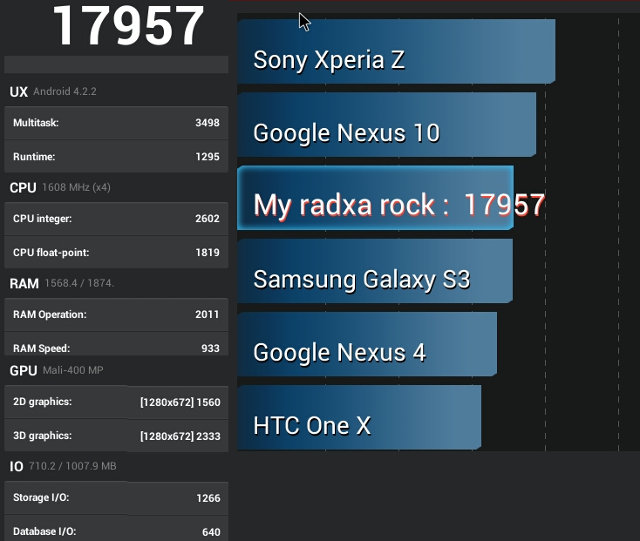 The board gets nearly 18,000 in Antutu 4 which is consistent with other RK3188 devices.
The board gets nearly 18,000 in Antutu 4 which is consistent with other RK3188 devices.
The score in Quadrant (5464) is also fine for a RK3188 based board.
You can find more information about Radxa Rock, and its little brother Radxa Rock Lite, on radxa.com, and if interested, purchase the board for $99 + shipping via Miniand, Seeedstudio or Aliexpress.

Jean-Luc started CNX Software in 2010 as a part-time endeavor, before quitting his job as a software engineering manager, and starting to write daily news, and reviews full time later in 2011.
Support CNX Software! Donate via cryptocurrencies, become a Patron on Patreon, or purchase goods on Amazon or Aliexpress




